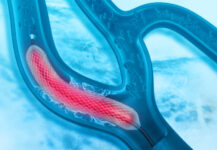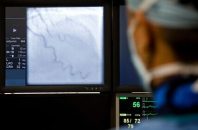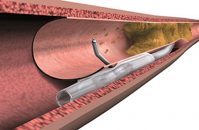The use of intravascular imaging to identify vulnerable plaque (VP) has proven to be very useful, as such plaque is associated with an increase in major adverse cardiac events. Optimal medical treatment is currently considered the standard strategy to stabilize VP. However, the safety and effectiveness of preventive treatment with percutaneous coronary intervention (PCI) in…
Lithotripsy in the “Real World”: REPLICA EPIC-18 Study
Severe persistent calcification of the coronary arteries has been associated with different factors, such as advanced age, hypertension, dyslipidemia, smoking, and kidney failure, among others, and continues to be one of the challenges to stent implantation because of it impact on device advancing, drug release and adequate positioning. Intravascular lithotripsy (IVL) is a technique that…
ISCHEMIA Outcomes: Does Sex Have Any Impact?
We are well aware of CAD physiopathological disparities and how it manifests differently in men and women. The ISCHEMIA study (International Study of Comparative Health Effectiveness with Medical and Invasive Approaches) has revealed that during 3.2 years no differences were seen in the incidence of ischemic events when comparing an invasive strategy (INV) vs a…
Use of IVL in Calcified Coronary Lesions in a Real World Population
The presence of calcification in coronary arteries (CAC) remains a challenge for the percutaneous treatment of these lesions. Several studies have established the link between CAC and poor long term results. Intravascular lithotripsy (IVL) has surged as a tool to induce calcified plaque fracture. Even though studies on this strategy are not randomized, they have…
PCI Evolution in Infiltrative Diseases
Infiltrative diseases (ID) consist of a heterogeneous series of genetic conditions that cause infiltration and extracellular deposits which alter the diverse systems and organs affected. Amyloidosis, sarcoidosis and hemochromatosis affect the heart, altering the myocardium and the conduction system. PCI is often used at present to treat heart disease, and some of these patients present…
Should We Treat Obstructive Coronary Artery Disease in TAVI?
Coronary artery disease, both obstructive and non-obstructive, often coexists with significant aortic stenosis. Therapeutic decision-making in this scenario remains controversial, not only regarding the need for treatment, but also about when it should be addressed, considering its pros and cons. Various analyses have yielded contradictory data, as most lesions are chronic and stable. Currently, the…
Relationship of Radial Wall Strain with Functional and Morphological Assessment of Coronary Artery Lesions
Radial wall strain (RWS) has been recently linked with plaque vulnerability and has been identified as a predictor of lesion progression and clinical outcomes. However, RWS should be assessed together with physiological indices and plaque characteristics. The aim of this post hoc analysis of the CCTA-FFR registry was to look into the link between RWS…
Use of Intravascular Lithotripsy vs. Rotational Atherectomy for Severely Calcified Coronary Lesions
Severely calcified coronary stenosis poses a significant challenge for coronary angioplasty procedures. Modifying plaque before stenting is crucial to a successful intervention, since it will prevent the sub expansion associated to worse clinical outcomes at followup. The tools employed to assess complex lesions include specialized balloons such as cutting, scoring, or high pressure balloons, as…
Use of IVUS in Complex PCI: Results according to Operator Experience
The use of ultravascular ultrasound (IVUS) to guide coronary angioplasty procedures (PCI) has been shown to reduce the risk of major adverse events in numerous randomized controlled studies, registries and meta-analysis. The current guidelines recommend the use of IVUS in left main disease and complex lesions. The proportion of complex PCI procedures has increased over…
Dissection and Re-Entry Technique in Chronic Total Occlusions: Data from the PROGRESS-CTO Registry
The antegrade dissection and re-entry (ADR) technique is considered essential for the management of chronic total occlusions (CTO). It serves as the primary option in some protocols for complex and extensive lesions or as a backup strategy in case of failure with other initial strategies. Dissection techniques include guided methods such as scratch and go,…
Retrograde Approach to Chronic Total Occlusions: Techniques and Outcomes According to the PROGRESS-CTO Registry
The retrograde approach for recanalizing chronic total occlusions (CTO) has undergone significant evolution since its introduction in 1990, improving both in terms of techniques and specialized materials. The increased skill applied to this strategy has resulted in increased success rates for the treatment of CTO in sites with an adequate volume of procedures. Given the…










